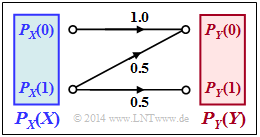Difference between revisions of "Aufgaben:Exercise 3.11Z: Extremely Asymmetrical Channel"
m (Guenter verschob die Seite 3.10Z Extrem unsymmetrischer Kanal nach 3.11Z Extrem unsymmetrischer Kanal) |
|
(No difference)
| |
Revision as of 10:04, 1 June 2017
Betrachtet wird der nebenstehend gezeichnete Kanal mit den folgenden Eigenschaften:
- Das Symbol $X = 0$ wird immer richtig übertragen und führt stets zum Ergebnis $Y = 0$.
- Das Symbol $X = 1$ wird maximal verfälscht. Aus Sicht der Informationstheorie bedeutet diese Aussage:
$${\rm Pr}(Y \hspace{-0.05cm} = 0\hspace{-0.05cm}\mid \hspace{-0.05cm} X \hspace{-0.05cm}= 1) ={\rm Pr}(Y \hspace{-0.05cm} = 1\hspace{-0.05cm}\mid \hspace{-0.05cm} X \hspace{-0.05cm}= 1) = 0.5 \hspace{0.05cm}$$ Zu bestimmen sind in dieser Aufgabe:
- die Transinformation $I(X; Y)$für $P_X(0) = p_0 = 0.4$ und $P_X(1) = p_1 = 0.6$. Es gilt allgemein:
$$ I(X;Y) \hspace{-0.15cm} =\hspace{-0.15cm} H(X) - H(X \hspace{-0.1cm}\mid \hspace{-0.1cm} Y)\hspace{0.05cm}$$ $$I(X;Y) \hspace{-0.15cm} = \hspace{-0.15cm} H(Y) - H(Y \hspace{-0.1cm}\mid \hspace{-0.1cm} X)\hspace{0.05cm}$$ $$I(X;Y) \hspace{-0.15cm} =\hspace{-0.15cm} H(X) + H(Y)- H(XY)\hspace{0.05cm}$$
- die Kanalkapazität:
$$ C = \max_{P_X(X)} \hspace{0.15cm} I(X;Y) \hspace{0.05cm}$$ Hinweis: Die Aufgabe beschreibt einen Teilaspekt von Kapitel 3.3. In der Aufgabe A3.13 sollen die hier gefundenen Ergebnisse im Vergleich zum BSC–Kanal interpretiert werden
Fragebogen
Musterlösung
4.Eine (mögliche) Gleichung zur Berechnung der Transinformation lautet: $$ I(X;Y) = H(X) + H(Y)- H(XY)\hspace{0.05cm}$$ Daraus erhält man mit den Ergebnissen der Teilaufgaben (a), (b) und (c): $$I(X;Y) = H_{\rm bin}(p_0) + H_{\rm bin}(\frac{1+p_0}{2}) - H_{\rm bin}(p_0) -1 + p_0 = H_{\rm bin}(\frac{1+p_0}{2}) -1 + p_0$$ $$ \Rightarrow \hspace{0.3cm} p_0 = 0.4 {\rm :}\hspace{0.5cm} I(X;Y) = H_{\rm bin}(0.7) - 0.6 = 0.881 - 0.6 \hspace{0.15cm} \underline {=0.281\,{\rm bit}}\hspace{0.05cm}$$ 5 Die Kanalkapazität $C$ ist die Transinformation $I(X; Y) $bei bestmöglichen Wahrscheinlichkeiten $p_0$ und $p_1$ der Quellensymbole. Nach Differentiation erhält man die Bestimmungsgleichung: $$\frac{d}{d_{p_0}} I(X;Y) = \frac{d}{d_{p_0}} H_{bin}(\frac{1+p_0}{2} +1\stackrel{!}{=} 0.$$ Mit dem Differentialquotienten der binären Entropiefunktion $$ \frac{d}{d_p}H_{bin} = log_2 \frac{1-p}{p}, $$ und entsprechendes Nachdifferenzieren erhält man : $$\frac{1}{2} \cdot {\rm log}_2 \hspace{0.1cm} \frac{(1-p_0)/2}{1- (1-p_0)/2} +1 \stackrel{!}{=} 0 \hspace{0.3cm} \Rightarrow \hspace{0.3cm} \frac{1}{2} \cdot {\rm log}_2 \hspace{0.1cm} \frac{(1-p_0)/2}{(1+p_0)/2} +1 \stackrel{!}{=} 0$$ $$ \Rightarrow \hspace{0.3cm} {\rm log}_2 \hspace{0.1cm} \frac{1+p_0}{1-p_0} \stackrel{!}{=} 2 \hspace{0.3cm} \Rightarrow \hspace{0.3cm} \frac{1+p_0}{1-p_0} \stackrel{!}{=} 4 \hspace{0.3cm}\Rightarrow \hspace{0.3cm} p_0 \hspace{0.15cm} \underline {=0.6}\hspace{0.05cm}$$ 6. Für die Kanalkapazität gilt dementsprechend: $$C = I(X;Y) \big |_{p_0 \hspace{0.05cm}=\hspace{0.05cm} 0.6} = H_{\rm bin}(0.8) - 0.4 = 0.722 -0.4 \hspace{0.15cm} \underline {=0.322\,{\rm bit}}\hspace{0.05cm}$$ In Aufgabe A3.13 wird dieses Ergebnis im Vergleich zum BSC–Kanalmodell interpretiert. 7. Für die Äquivokation gilt: $$ H(X \hspace{-0.1cm}\mid \hspace{-0.1cm}Y) = H(X) - I(X;Y) = 0.971 -0.322 \hspace{0.15cm} \underline {=0.649\,{\rm bit}}\hspace{0.05cm}$$ Wegen $H_{bin}(0.4) = H_{bin}(0.6)$ ergibt sich die gleiche Quellenentropie $H(X)$ wie in Teilaufgabe (a). Die Sinkenentropie muss neu berechnet werden. Mit $p_0 = 0.6$ erhält man $H(Y) = H_{bin}(0.8) = 0.722 bit$, und damit ergibt sich für die Irrelevanz: $$H(Y \hspace{-0.1cm}\mid \hspace{-0.1cm} X) = H(Y) - I(X;Y) = 0.722 -0.322 \hspace{0.15cm} \underline {=0.400\,{\rm bit}}\hspace{0.05cm}$$
